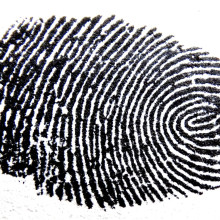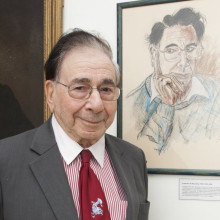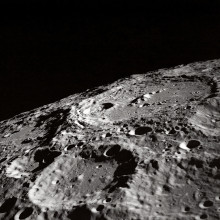Depression drugs, deepfakes, and fingerprint discoveries
On this week's edition of The Naked Scientists: Why a dose of old drugs might be a new way to beat depression; with many countries gearing up for general elections, why AI-generated deepfakes have got politicians worried; And we look back at the life of the pioneering British transplant surgeon, Professor Sir Roy Calne..
In this episode

00:59 - Ketamine and psilocybin alter depression-tinted memories
Ketamine and psilocybin alter depression-tinted memories
Emma Robinson, University of Bristol
New research suggests that mood-altering drugs such as the anaesthetic ketamine and the hallucinogen psilocybin can help alleviate symptoms in difficult to treat cases of depression. The experiments - which were carried out on rats by a team at the University of Bristol - suggest that people with depression tend to attach negative emotions to memories. Breaking those associations, which the experimental drugs seem to do, appears to boost mood for extended periods of time. Professor Emma Robinson conducted the research...
Emma - People with depression tend to think about things and remember things in a negative or pessimistic way. And we think that this is important in contributing to why they have a low mood and perpetuating the illness. We also think the treatments for depression might actually be affecting these pathways in the brain that generate this sort of negative thinking. And so this project was all about asking that question. Do these drugs specifically interact with this kind of negative thinking and these pathways involved in negative thinking?
Chris - Are these new drugs or are they old drugs that we're finding a new way to use?
Emma - No, they're not new. That's what's really interesting. I mean, one of the drugs is ketamine. It's been used as an anaesthetic. It's a well-known drug of abuse. And the other drug that we've particularly been interested in is psilocybin, which is a psychedelic, and it's something which we've known about probably for millennia.
Chris - And how did it come to light that they had these interesting properties then?
Emma - About 20 years ago, somebody thought it would be interesting to see what would happen if they gave people a single dose of ketamine and what would happen to patients who had treatment resistant depression. And I think everybody was really surprised when the drug had this very rapid and long lasting effect after single treatment. People were feeling better within 24 hours and they stayed better for many days.
Chris - So how have you tried to unpick what you think is going on then?
Emma - So what we're doing is we're forming specific memories and then we're using different treatments to shift those memories by a virtue of the emotion at the time they learn it. So if you imagine you find something that's worth £10. When you experience that in a negative emotion, it's valued a bit less. So it's like when people have depression, they can experience positive things, but they value them less and that means that they're less likely to remember them positively. The drugs seem to have quite a specific effect on the part of the brain that creates that sort of emotional part of a memory. So it doesn't change the memory itself, but where a memory might have been not very valued because it was learned during a depression--like state. When they've had the drug and we ask them to retrieve the memory, it's actually become more positive.
Chris - How did you do this in your rats though, to reach that conclusion?
Emma - So we just give them very specific memories and the memories are that a particular thing that they dig in has food in it, and they had to remember that. And rats are brilliant at it. And then we ask them the simple question, which of these memories do you prefer? And when they've experienced the memory after a negative or a depression-like state, they don't like that experience as much as they like the one in a neutral state. And so we're asking them to say, which one do you prefer? And we can manipulate that with the drug treatments.
Chris - So you've got your food item in different things. They can dig in and they've dug in one when they're feeling in a low mood and they've dug in another when they're feeling in a good mood and you present them with the choice and you say which ones you want, whereas you can break that association with these drugs.
Emma - We can break that, yeah. And what's particularly exciting was that we didn't just break it, but actually a day later, that previously negative memory had actually become more positive. So it had shifted to the other side. So it was actually better than what they'd learned on the neutral day.
Chris - And you can prove it's not just these drugs having an amnesic effect. They're not just forgetting that they were depressed because they still remember there was food. It was in that particular material and have to dig for it. So they've still got a memory there, but they're regarding it as less negative than they used to.
Emma - Yeah, that's right. So we actually do a control experiment. So we do a different type of memory test where we use exactly the same treatments, but this time there's no emotional component to it. And these drugs have no effect on that at all. So it's not just amnesia, it's a very specific effect on this sort of emotional part of the memory.
Chris - Do these experiments give you any insight into why people tend to, if they have a tendency towards depression and negative mood, that they have this problem in the first place, why they are emotionally loading their memories in this bad way? So they tend to overemphasise the negatives and underemphasise the contribution of the good things
Emma - We don't yet. So that's very much where we want to see this work going. We have the potential now to use this same sort of approach to now ask questions. So in someone who has depression. So can we, if we model depression itself in a rat, can we actually see these changing in that way? So we did some work a few years ago where we found that actually if animals experience adversity early in their lives, then they actually become more pessimistic in their thinking. So a bit like what we see in depressed people. So we do think that perhaps in depression there's this sort of adaptive change in these parts of the brain making people sort of become more pessimistic.

06:38 - Could AI deepfakes cause havoc in upcoming elections?
Could AI deepfakes cause havoc in upcoming elections?
Sander van der Linden, University of Cambridge
This year, a record-breaking number of countries - 40 in fact - will hold national elections. The outcomes could potentially shape the course of global politics for decades to come. But there are fears that artificial Intelligences - which have already been used to disrupt ballots around the world - could be used to exert undue influences and bias the results. So, should we be concerned? Sander van der Linden is a professor of social psychology at the University of Cambridge and author of Foolproof: Why We Fall for Misinformation and How to Build Immunity.
Sander - One of the threats is really that AI is democratising the production of disinformation. So what I mean by that is, before large language models, individuals or groups of concerted people trying to make up stuff and then find vulnerable targets. But now with ChatGPT, anyone can create disinformation just from their own bedroom. It's actually really easy to do, and we've done it in our lab. People have done it on the internet, so that makes it easier to create this information, but also to automate it. So you may have heard of microtargeting, which is using your digital footprint, so the times you spend on Facebook clicking on things or the traces you leave behind on Google search, to try to find out information about you and then target you with ads, uh, because we know that it's more persuasive and people more likely to click on it. But you can do that with fake information too. Before troll farms, factories where people worked en masse to produce false information, we'd have to manually write individual messages and say, 'okay, well this person is a bit more extroverted, so we're going to write a fake extroverted message. This person's a bit more introverted, so we're going to write a fake introverted message.' Of course now with ChatGPT, it can create hundreds of messages. You just prompt it and say, I want to write a message for somebody who's extroverted or introverted, and it can do that at a great scale. And so it really eliminates the labour and so you can automate this process of micro-targeting. So it makes it easier for bad actors, not only to generate the disinformation, but target it at specific audiences.
Chris - So we have two problems, then we've got the fact that more people can do more bad things, and we can also make the stuff that's being made more targeted, more focused, and potentially therefore more effective at biasing people in the wrong way.
Sander - That's right. The immediate problem is that people are not good at identifying manipulated imagery and deep fakes. Up to 20 to 30% of political images are manipulated. Often people don't seem to know the difference. In tests, when you do studies, people do very poorly at identifying deepfakes from genuine content. We also know that people deem AI generated disinformation as more persuasive than human written disinformation because the AI makes it more succinct, more easily accessible than human writing. And then lastly, I think the most convincing evidence that this is actually a problem is that there have been studies where they target people with a deepfake of a politician saying something false on purpose to try to antagonise a voter base. So in this study, they're making a joke about religion, for example, to try to offend religious voters. This is totally false, but it looks like it's the politician and they actually found in a randomised experiment that it has impacted people's intentions to vote for this candidate and their policies.
Chris - So it sounds like there really is a potentially big problem with all of this. Is not the solution though, really the message that you have been putting out there all along, which is that if you pre-warn people what to look for, they're less likely to fall into these sorts of traps. I looked at the video footage of Zelenskyy, apparently suggesting that his countrymen should lay down their arms and surrender to Russia. It looked pretty plausible until I then read someone saying, 'this is what to look out for. That tells us this is fake.'
Sander - To some extent, yeah,. I think that AI does pose some unique challenges to this idea of pre-bunking that you mentioned, to try to preemptively build resilience. So in our lab, we do these sorts of quizzes on ourselves too. And supposedly we're trained experts. Sometimes we don't know if the image is manipulated or not. We had a computer scientist visit us who specialises in deep fakes, and it was really illuminating. So yeah, it is true that you can preemptively teach people some of the tricks, right? That there's flickering around the eyes or the hair is kind of floating or there's stuff in the background that shouldn't be there totally out of place. And that works for a period of time until the technology updates. And if you compare this to the viral analogy, once the virus mutates maybe we need to update the vaccine. And so that's the challenge with AI. With all the stuff that we've been doing before, it's kind of permanent. We give people the fingerprints of misinformation. We expose them to weakened doses and help them refute it in advance and then become more immune. But AI is changing at a faster rate than other types of misinformation. So that does pose a challenge. So we've been thinking about what are the stable features that would help people in advance? And one of those features is context. So these videos tend to be presented in contexts that are not really plausible. For example, would the Pope wear a puff jacket? Because it's hard from the rest of the image to know whether it's real or fake. Does this context make sense? And manipulators will try to use political context often to insert these videos.
Chris - Or is it that we as humans are just too flawed and fallible and weak-minded to see through the veil of AI, and in fact we need an AI to defend us from AI. Is that going to be how it works out? Our media that's presented to us, our phone will have, in the same way as it has antivirus on there, may have an AI filter that calls BS on stuff that doesn't really look plausible.
Sander - Well, you know, I think it's a good idea for people to have assistance, right? We're all operating on the conditions of limited time and resources. So sure, if you had endless time and you could Google everything, you may be able to figure it out, right? But in real life, we're massively constrained. And so the question becomes, can AI assist us? And yes, you can train AI to detect manipulation techniques online to automate it, to help you detect them. We also used AI to produce a test, which we call the misinformation susceptibility test, which is a quiz anyone can take to test themselves. But the headlines were actually generated by an AI. And so AI can also assist in education. So I would think of it as a tool that we can harness to assist people in recognising and identifying misinformation.
Chris - Are you worried, do you think this is likely to skew the results of these elections this year and next?
Sander - Yeah, that's the big question. What worries me is that there's very little regulation that actually prevents political actors from using AIs in deceptive ways in their campaigns. And that's true I think both in the US and, maybe to a somewhat lesser but still to some degree, in the UK. And they have been used, politicians have used deepfakes of their opponents and people have fallen for them. It's kind of mind boggling that regulation is lagging to such a degree that we actually don't know how to legislate or regulate the use of deepfakes during elections. Because ads are allowed, right? And if you use deepfakes for ads. But it becomes easy to subtly manipulate people. So you can run an ad with the assistance of AI, but then it can ad lib and produce things that aren't there, can simulate situations that are not maybe outrightly false, but clearly manipulative and where's the line? And so I think for people, what's happening is that reality is getting blurred. People are left to their own devices to figure it out in the absence of any type of regulation. And that does worry me that people are going to be influenced by this technology. So I would say that AI assisted disinformation is coming to an election near you.

15:00 - AI fingerprint breakthrough could aid future forensics
AI fingerprint breakthrough could aid future forensics
Gabe Guo, Columbia University
The field of forensics has long assumed that no two fingerprints are ever alike, even on different fingers from the same person. But, analysis from scientists at the Creative Machines Lab at Columbia University challenges this conventional wisdom. By asking an artificial intelligence to take a look at a suite of tens of thousands of publicly available fingerprints, Gabe Guo has found that there are features that are more similar in prints from the same person, after all...
Gabe - This research started as a chat between me and Professor Wenyao Xu at the University of Buffalo. And me and him were just having a chat and he asked me at the end, 'do you think that all fingerprints are really unique? Think about fingerprints from different fingers of the same person. They come from the same genetic material, so don't you think they might be correlated?' And once he said that, I was like, that's a really interesting idea. Let me go investigate this. And to bring a long story short, little did I know that one conversation would form the basis of my life's focus for the next three years
Chris - Are all fingerprints of a person not in some way similar then, because I always thought that fingerprints from an individual had common features or factors, which is how we identified a criminal for example.
Gabe - I think there may have been a hunch among some people that there is a relation between different fingerprints from the same person, but no one was ever able to provide quantitative or explainable evidence to substantiate this claim. And that's really our contribution. We were the first in the world to systematically analyse it, use statistics and say there is this similarity and specifically we can get more into that later. It comes from the angles of the fingerprint ridges at the centre.
Chris - Does that mean then that when the police go and investigate, say a crime scene or border control are collecting people's fingerprints, that if they had two fingerprints from different fingers, they previously would've said, 'well we can't say that that was the same person.'
Gabe - Right. They would have no way of matching them before our discovery.
Chris - So what have you done then that's turned the tables on all this?
Gabe - We wanted to come at this with a unique perspective because we knew that forensic science was not able to correct the question. So we thought, okay, what about we just feed it to an AI model? And really the power behind AI models is they can automatically learn what the relevant parts and features and characteristics of an image are that they should focus on. So we fed our fingerprints into an AI model. The idea was just to say, 'okay, are these two fingerprints from the same person or from a different person?' And after analysing tens of thousands of fingerprints, the AI model was able to not only identify them with very high accuracy, but also after looking into what the AI model was analysing, we were able to find the causes of the similarity, which is the angles of the fingerprint ridges at the centre.
Chris - Most AI models though are not what we call explainable. When you ask them how they reach the conclusion that they do, they can't tell you. And this is one of the reasons why people tend to not trust them or have some degree of scepticism. So how does yours explain to you what it's seeing and to show that two sets of prints from the same person have these relationships?
Gabe - Yeah, that's a great question. And actually that was the sticking point and the thing that took us the most time with the research. So there are two ways to do it and we employed both ways. The first way is what's known as ablation. You take the data you have and you degrade it in some way. So for our data we said okay, if we make it only black and white, can it still find the similarities? Okay, that works. What if we only have the angles of the fingerprint ridges and we take out all notion of thickness or colour. And that still works to almost the same accuracy. So we were able to say, okay, we're pretty sure that the similarity comes from the angles of the fingerprint ridges regardless of colour or thickness. The second way we analysed it was we saw which parts of the images caused the AI's neurons to light up the most. And after systematically doing that a bunch of times we found out that almost always it was the centres of the fingerprints that caused the AI's neurons to really fire.
Chris - So explain that for us a bit then. What exactly is it that it's found that shows these similarities? I know you said there is a region, but what is it about those bits of the fingerprint that are so similar between individuals?
Gabe - Fingerprints fall into some categories, some fingerprints loop back in on themselves. There's some fingerprints that don't really loop back in on themselves and so on and so forth. It looks at that same region, but it doesn't exactly look at just that macro characteristic. It looks at something a little bit more subtle. The angles in that central region where you kind of have the curvature determined, but then there's some subtle things it's doing that kind of mould all those together into the final prediction.
Chris - And how good is it in the sense that how hard would I have to try in percentage terms to fool it? How often does it get it wrong? Did you find any situations where it would slip up? Because of course that is critical. When it comes to forensics, a jury wants to be X number of decimal places percent sure that this is not happening by chance.
Gabe - So as currently constructed, this technology cannot be used to be deciding evidence in the court case because depending on the conditions, the accuracy ranges from 75% to around 90%. So as you mentioned, it's still not good enough to be used as evidence in court cases.
Chris - So do you think you can improve on that or is this just a useful tool it gives police or investigators the reassurance that they need sometimes that they're on the right lines, they need to go and find other corroborating evidence? Or do you think you can get this up to the magic sort of 99.99% that it's probably going to take to be admissible?
Gabe - Yeah, I believe that we can get it to that high state of 99% because when we did studies investigating how much data our model needed, we found a very strong trend that, as you add more data, the performance shoots up a lot. And unfortunately for this study we were limited by there being only 60,000 publicly available fingerprints. But I'm sure that after this study comes out, we'll be able to get access to more fingerprints and train a much stronger model.

21:37 - Roy Calne, pioneering transplant surgeon, dies aged 93
Roy Calne, pioneering transplant surgeon, dies aged 93
Chris Watson, Angela Dunn, Eric Dunn
Tributes have been paid this week to the British transplant surgeon, Professor Sir Roy Calne, who has died at the age of 93...
Chris - The word pioneer is frequently overused in medical science, but there are a few who have deserved it more than Professor Sir Roy Calne, whose groundbreaking work not only helped to save and prolong the lives of thousands of people, but also transformed the profession's understanding of organ transplantation. During his remarkable career, Sir Roy conducted a series of scientific firsts. Europe's first successful liver transplant at Addenbrooke's Hospital here in Cambridge in 1968. The UK's first intestinal transplant in 1992 and the world's very first successful organ cluster transplant shortly after in 1994. All astonishing breakthroughs. But what made all of this possible was Roy Calne's visionary use of new immunosuppressive drugs that could prevent immune rejection, having achieved modest success with earlier generations of immune suppressing drugs. It was his use in 1978 of the agent cyclosporine that proved to be the greatest game changer as he later outlined to the General Medical Council.
Roy - It was really a watershed in transplantation because prior to cyclosporine there were only about 10 centres in the world seriously doing transplants. After cyclosporine, within two or three years, there were more than a thousand, because cyclosporine made kidney transplantation respectable.
Chris - Roy Calne was born in Richmond in Surrey on the 30th of December, 1930, he attended Dulwich Prep School in South London and then Lansing College in West Sussex. At the end of the Second World War, and at the tender age of just 16, this gifted student was accepted to study medicine at Guy's hospital in London. Calne would begin his military service with the Royal Army Medical Corps in 1953. It allowed him to travel the world with his girlfriend of the time, Patsy, who was a nurse at Guy's Hospital. Roy and Patsy subsequently married when they were in Hong Kong, and later raised four daughters and two sons. Sir Roy continued to travel widely, but it was his time spent here in Cambridge for which he will be best remembered. Professor Chris Watson, himself a transplant surgeon who worked with Roy Calne, has credited the great surgeon with putting the city on the map as an international centre for excellence.
Chris Watson - He wasn't your archetypal throwing instruments and shouting. It was much quieter. He didn't throw any instruments. He'd often have chamber of music or such like playing in the background while he operated. He was a very fast surgeon. This came from when he first started surgery and couldn't preserve organs out of the body for very long. So it really was an imperative to get on and implant them very quickly, so Roy was a very quick surgeon. If you had an idea and made a suggestion, he'd listen to you and he may follow your suggestion or tell you why it wasn't appropriate at that time. Very keen on chatting to other patients. Whenever he was in Cambridge, he'd make it a point to come to the evening ward rounds to see all the transplant patients and chapter them. And there'd be an entourage of sometimes 5, 10, sometimes 20 people following him around on the ward rounds. It's a bit intimidating for the patients. But actually Roy had a very good relationship with the patients and luckily he'd often sit some of them down and paint their portraits.
Chris - What do you think his legacy is? If you could just summarise it in a line, what picture would you paint of Roy Calne.
Chris Watson - He transformed transplantation both for those he directly operated on, but for the specialty as a whole in the immunosuppressants that he introduced and the possibility of chemical immunosuppression that he conceived of. His other legacy I think is in the people he trained, many of whom have gone on to great things. And he instilled in them this never say die aptitude that was characteristic of himself. You wouldn't say you can't do this because you'd seen Roy tackle things that you really thought were impossible and do it methodically and successfully.
Chris - Chris Watson there. Sir Roy was rightly recognised for his work. He was knighted in 1986 and he was given a Pride of Britain Award in 2014 that was presented by Katie Piper, who underwent a stem cell and cornea transplant after an acid attack. She is said to have told Roy that his work changed her life and allowed her to see her first child. Certainly the pioneering work conducted by Professor Calne has allowed many people to go on to lead happy, healthy, and active lives. One of them is Angela Dunn, who had a life-saving kidney transplant performed by him more than half a century ago in 1970. Angela has the longest lasting kidney transplant in the world and she spoke to me from a home in France where she remains happy and healthy.
Angela - I was transplanted in 1970 by Professor Calne who came one July evening to RAF Halton, where I was a patient, and gave me back my life. I'm not going to say that every time I spend a penny I think of Sir Roy, but there is that constant reminder that my kidney, and its functioning, is the result of what he did nearly 54 years ago.
Chris - Let's turn to Eric, your husband Eric, former RAF man. What's your recollection of Sir Roy Calne and the difference he made to Angela.
Eric - After the operation, he was so full of confidence and reassuring that you felt it had to go right and indeed it did. He was brilliant, a pioneer and all pioneers deserve respect. Brilliant.
Chris - The last time I spoke to the pair of you, you were both standing there talking to me on Zoom in France where you now live with glasses of red wine. I'm pleased to see that history is repeating itself. It's a bit colder, but you are still glass in hand, and hale and hardy by the look of it.
Angela - <laugh>. Well, we do our best. We're a little older. We follow the dog who is now 12, but thinks he's two. We try to follow his example.
Chris - Angela Dunn, transplant recipient and patient of Professor Sir Roy Calne. Remembering the great surgeon who died at the age of 93.
--------------------------------------------------------------------------------------------------------------------------------------------
Thank you to the Medical Research Council for the use of their clip of Sir Roy Calne featured in this content.

Peregrine lunar lander fails to reach the Moon
Richard Hollingham
There was much excitement this week when a private US company launched a mission to touch down on the Moon’s surface… but it’s not gone to plan. Richard Hollingham is a science journalist, author and BBC presenter.
Richard - Well, Peregrine is, and it will still exist, but it won't land on the moon. It's a private lender. So it had NASA instruments and instruments from other space agencies on board, but it was built by a private company, and NASA bought space on it. There were three cool things about it. Firstly, that it's a private launcher and there's a whole business in private launches, private landers. It was a new launcher and that worked. That was the Vulcan. And also it was going to be the first US soft landing on the moon since 1972. That's not going to happen now, but a lot of it has been good.
Chris - Do we know what has gone wrong?
Richard - It's a propellant leak. We don't know all the details, but they've been tinkering with the software and the hardware on board remotely just to eke out the fuel as much as possible. So yeah, it's a fault with the lander. But this is a new lander. It's a new enterprise. Things like this happen all the time. Elon Musk last year had two massive explosions with these new rockets he's developing and they're carrying on building new big giant rockets.
Chris - Elon Musk had his 'unscheduled disassembly moment', didn't he? I think that's how they dubbed it, wasn't it? But what will they be able to do with Peregrine or what have they done despite the propellant problem?
Richard - Well, the instruments are still working. What they're hoping to do is to be able to get it into lunar orbit and maybe do some science. I mean, it tests out the hardware if nothing else, even if they can't get the instruments to work. But it is stable. They have got it under control. It just hasn't got any fuel to be able to actually land on the moon. But don't worry, there's another private mission coming along. A company called Intuitive Machines is aiming to launch in February, and they're aiming to land their lander in another private mission near the lunar south pole.
Chris - NASA has some capacity there as well. Do they?
Richard - They do. They have an instrument on there in particular that's going to look at what the impact of landing a rocket on the moon is. So the ejection, what sort of spews up from the moon, which is going to have implications for other landers, particularly when we come to land humans on the moon.

30:50 - Did women cook the food in the Palaeolithic?
Did women cook the food in the Palaeolithic?
Thanks to Dr Emma Pomeroy for the answer!
Will - To answer this question, we are picking the brains of paleoanthropologist at the University of Cambridge, Dr. Emma Pomeroy.
Emma - I mean, this is a really good question, and I think unfortunately the answer is that we don't know. The question itself does reflect some of our assumptions, and actually if we look at the ethnographic record, so what recent forager societies do, actually we see both men and women cooking food and quite often cooking food on the go. If they find some tubers or if they hunt a small animal, they'll make a small fire and cook the food and eat it as they're moving around.
Will - Did they bring more substantial things back? Would that be a different case then? Would they need to cook that on site?
Emma - Yeah, I mean, sometimes food is brought back to an essential place and might be cooked with a more substantial fire. But quite often I think we see that it's both men and women getting involved in that. So all members of the community. There's also the question of whether we can actually assume that any kind of gender roles and gender division of labour actually applied in the past as well. And again, that's been pretty controversial. People have tried to look at whether we can see differences from the skeleton in what men and women are doing. But linking that back to cooking specifically is really hard.
Will - So is it more of a case of whoever found it, cooked it?
Emma - Yes, quite possibly. Or that people cooked it as a group with various people chipping in. If it's something larger, more substantial, that's going to be shared.
Will - Thank you very much Natalie for your question, and thank you to Emma Pomeroy for the answer. Next week, we're answering this question from listener Kathryn, who after her cataract surgery had this to inquire about her new set of eyes.
Kathryn - Why is it with replacement lenses, which are fantastic? Does facial recognition still work? But biometrics do not seem to.
Will - And if you do have a question of your own or you think you know the answer to this one, the email address is chris@nakedscientists.com or join us on the forums nakedscientists.com/forum.










Comments
Add a comment